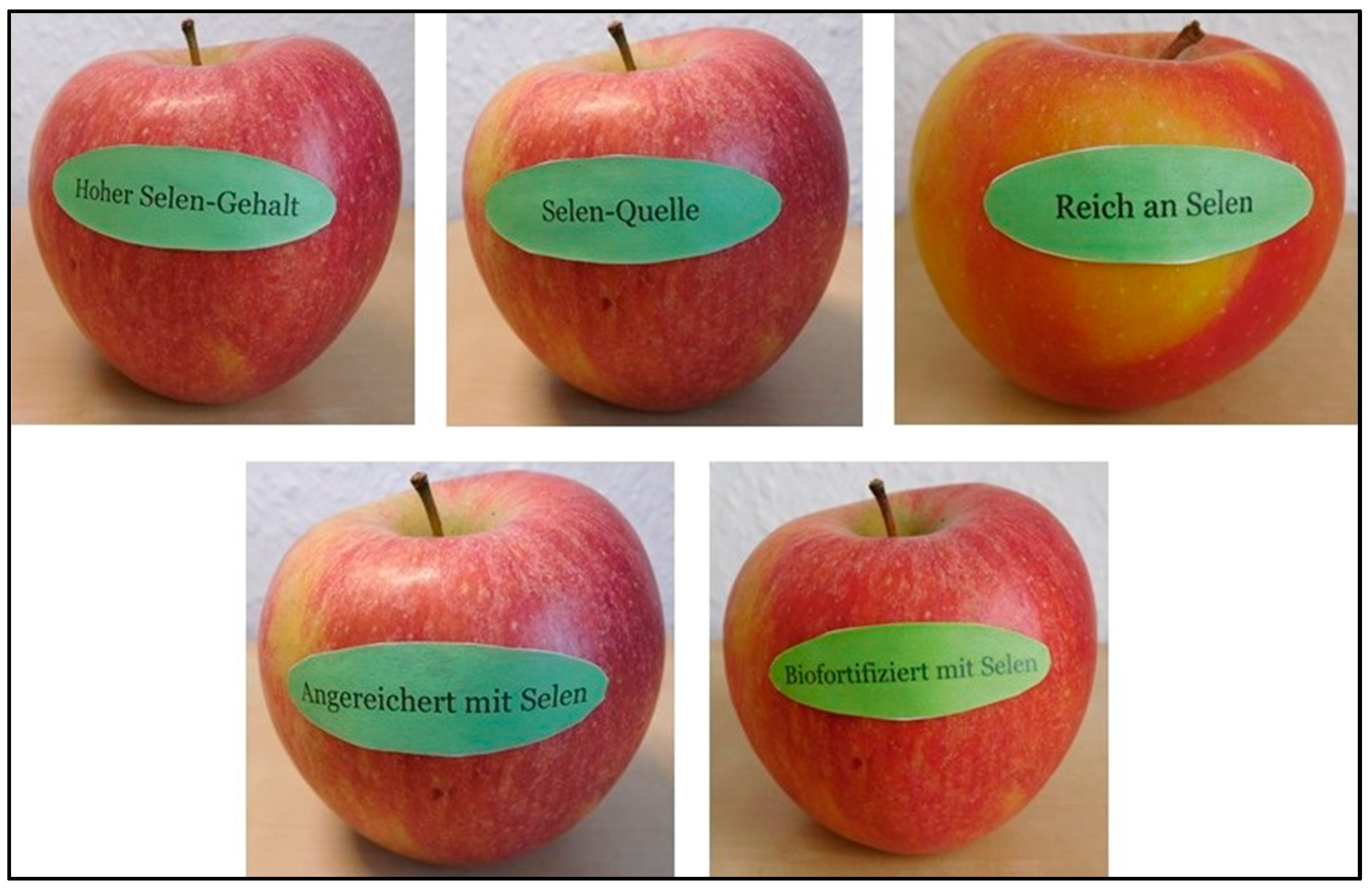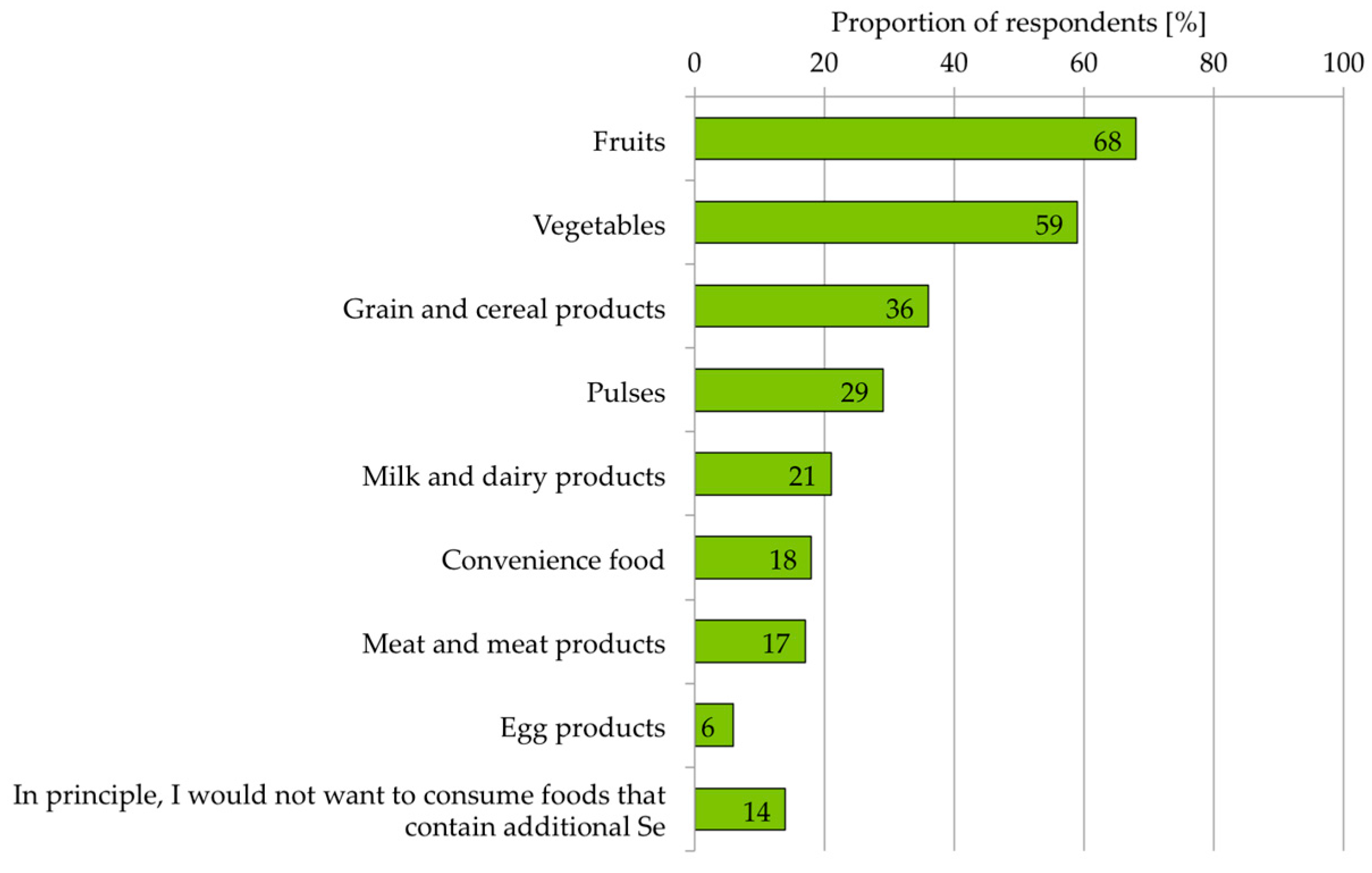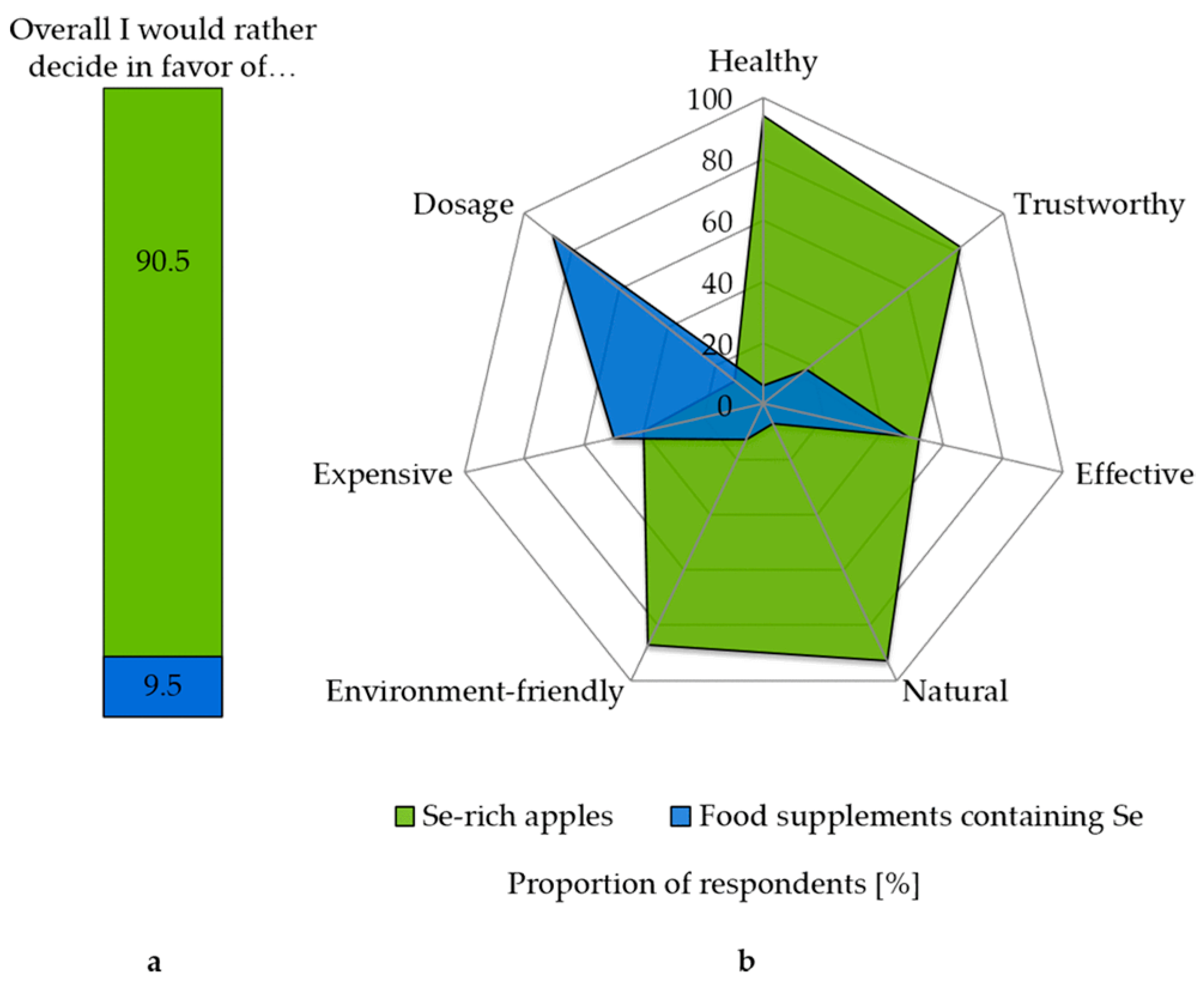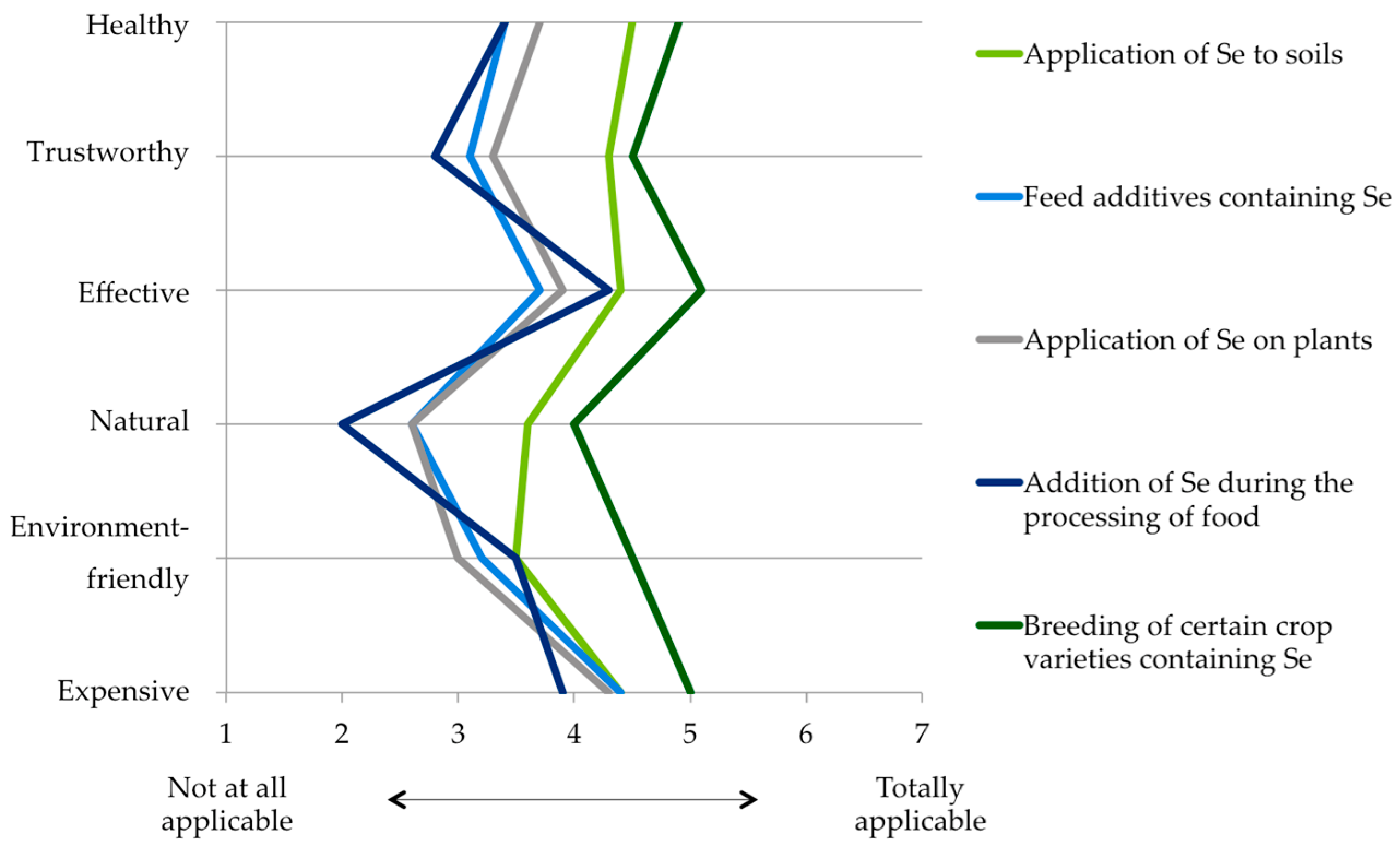German Consumers’ Attitude towards Selenium-Biofortified Apples and Acceptance of Related Nutrition and Health Claims
Abstract
:1. Introduction
- (1)
- Is the acceptance of Se-biofortified apples influenced by nutritional behavior, health awareness, usage habits regarding food supplements and demographic aspects?
- (2)
- Which food categories are suitable for optimizing the Se intake from the consumers’ point of view (2a)? Are natural products, such as Se-enriched apples, more likely to be accepted than food supplements (2b)?
- (3)
- Which nutrition (3a) and health claims (3b), approved by the European Commission, are most appealing to consumers with regard to Se-biofortified apples?
- (4)
- Can consumer acceptance of Se-related nutrition claims significantly be improved by providing information regarding the health effects of Se?
- (5)
- How do consumers assess alternative methods to increase the Se content in food?
2. Materials and Methods
2.1. Study Design
- (1)
- Application of Se to soils, thereby increasing the Se content in crops
- (2)
- Usage of feed additives containing Se in animal husbandry
- (3)
- Application of Se on plants, especially suitable for fruits and vegetables
- (4)
- Addition of Se during the processing of food
- (5)
- Breeding of certain crop varieties containing Se
2.2. Data Collection and Sample
2.3. Analysis
3. Results
3.1. Influencing Factors on the Acceptance of Se-Biofortified Apples
3.2. Consumers’ Attitudes towards Different Dietary Se Sources and Influencing Factors in the Decision-Making Process between Se-Biofortified Apples and Food Supplements
3.3. Acceptance of Nutrition and Health Claims for Se in Apples
3.4. Effect of Explanatory Information about Se on the Acceptance of Se Nutrition Claims
3.5. Perception of Various Methods for (Bio-)Fortifying Foods with Se
4. Discussion
4.1. Se-Biofortified Apples as a Novel Approach to Addressing Se Deficiency in Germany
4.2. Influencing Factors on the Acceptance of Se-Biofortified Apples
4.3. Consumers’ Attitudes towards Different Dietary Se Sources and Influencing Factors in the Decision-Making Process
4.4. Acceptance of Nutrition and Health Claims for Se in Apples
4.5. Effect of Information about Se on the Acceptance of Se Nutrition Claims and Strategies to Launch Se-Biofortified Products in the Food Market
4.6. Limitations of the Study Presented and Implications for Further Research
5. Conclusions
Acknowledgments
Author Contributions
Conflicts of Interest
Appendix A


| Criteria | M | SD |
|---|---|---|
| Taste | 6.60 | 0.92 |
| Origin | 5.09 | 1.73 |
| Appearance | 4.63 | 1.50 |
| Price | 4.28 | 1.49 |
| Apple variety | 4.22 | 1.90 |
| Organic farming | 3.82 | 1.82 |
| Application of Se to Soils | Feed Additives Containing Se | Application of Se on Plants | Addition of Se During the Processing of Food | Breeding of Certain Crop Varieties Containing Se | |
|---|---|---|---|---|---|
| Healthy | |||||
| M: | 4.50 | 3.36 | 3.66 | 3.38 | 4.84 |
| SD: | 1.86 | 1.66 | 1.69 | 1.73 | 1.86 |
| Trustworthy | |||||
| M: | 4.25 | 3.06 | 3.34 | 2.81 | 4.52 |
| SD: | 1.89 | 1.71 | 1.61 | 1.55 | 1.93 |
| Effective | |||||
| M: | 4.42 | 3.66 | 3.88 | 4.32 | 5.10 |
| SD: | 1.65 | 1.64 | 1.65 | 1.80 | 1.60 |
| Natural | |||||
| M: | 3.56 | 2.62 | 2.65 | 1.99 | 4.04 |
| SD: | 2.13 | 1.66 | 1.62 | 1.37 | 2.06 |
| Environment-friendly | |||||
| M: | 3.50 | 3.23 | 3.04 | 3.51 | 4.52 |
| SD: | 1.87 | 1.73 | 1.54 | 1.75 | 1.94 |
| Expensive | |||||
| M: | 4.43 | 4.36 | 4.32 | 3.92 | 4.99 |
| SD: | 1.69 | 1.59 | 1.56 | 1.61 | 1.69 |
References
- Huang, Z.; Rose, A.H.; Hoffmann, P.R. The Role of Se in Inflammation and Immunity: From Molecular Mechanisms to Therapeutic Opportunities. Antioxid. Redox Signal. 2012, 16, 705–743. [Google Scholar] [CrossRef] [PubMed]
- Hughes, D.J.; Duarte-Salles, T.; Hybsier, S.; Trichopoulou, A.; Stepien, M.; Aleksandrova, K.; Overvad, K.; Tjønneland, A.; Olsen, A.; Affret, A.; et al. Prediagnostic Se status and hepatobiliary cancer risk in the European Prospective Investigation into Cancer and Nutrition cohort. Am. J. Clin. Nutr. 2016, 104, 406–414. [Google Scholar] [CrossRef] [PubMed]
- Rayman, M. Se Intake and Status in Health & Disease. Free Radic. Biol. Med. 2017, 112, 5. [Google Scholar] [CrossRef]
- Winkel, L.H.; Vriens, B.; Jones, G.D.; Schneider, L.S.; Pilon-Smits, E.; Bañuelos, G.S. Selenium cycling across soil-plant-atmosphere interfaces: A critical review. Nutrients 2015, 7, 4199–4239. [Google Scholar] [CrossRef] [PubMed]
- Bañuelos, G.S.; Lin, Z.Q.; Broadley, M. Se Biofortification. In Selenium in Plants; Pilon-Smits, E., Winkel, L., Lin, Z.Q., Eds.; Springer International Publishing: Basel, Switzerland, 2017; Volume 11, pp. 231–255. [Google Scholar]
- Poňavič, M.; Scheib, A. Distribution of Selenium in European Agricultural and Grazing Land Soil. In Chemistry of Europe’s Agricultural Soils—Part B: General Background Information and Further Analysis of the GEMAS Data Set—Geologisches Jahrbuch (Reihe B103); Reimann, C., Birke, M., Demetriades, A., Filzmoser, P., O’Connor, P., Eds.; Schweizerbart: Stuttgart, Germany, 2014; pp. 131–144. ISBN 978-3-510-96847-3. [Google Scholar]
- Rayman, M.P. Food-chain selenium and human health: Emphasis on intake. Br. J. Nutr. 2008, 100, 254–268. [Google Scholar] [CrossRef] [PubMed]
- Meyer, U.; Heerdegen, K.; Schenkel, H.; Dänicke, S.; Flachowsky, G. Influence of various Se sources on Se concentration in the milk of dairy cows. J. Verbrauch. Lebensm. 2014, 9, 101–109. [Google Scholar] [CrossRef]
- Rayman, M.P. Selenium and human health. Lancet 2012, 379, 1256–1268. [Google Scholar] [CrossRef]
- Schomburg, L. Plant-Based Diets and Se Intake and Status. In Vegetarian and Plant-Based Diets in Health and Disease Prevention; Mariotti, F., Ed.; Academic Press: London, UK, 2017; pp. 729–746. ISBN 978-0-12-803968-7. [Google Scholar]
- Stoffaneller, R.; Morse, N.L. A Review of Dietary Se Intake and Se Status in Europe and the Middle East. Nutrients 2015, 7, 1494–1537. [Google Scholar] [CrossRef] [PubMed]
- Oster, O.; Prellwitz, W. The daily dietary selenium intake of West German adults. Biol. Trace Elem. Res. 1989, 20, 1–14. [Google Scholar] [CrossRef] [PubMed]
- Kipp, A.P.; Strohm, D.; Brigelius-Flohé, R.; Schomburg, L.; Bechthold, A.; Leschik-Bonnet, E.; Heseker, H. Revised reference values for selenium intake. J. Trace Elem. Med. Biol. 2015, 32, 195–199. [Google Scholar] [CrossRef] [PubMed]
- EFSA Panel on Dietetic Products, Nutrition and Allergies (EFSA NDA Panel). Scientific Opinion on Dietary Reference Values for selenium. EFSA J. 2014, 12, 3846. [Google Scholar] [CrossRef]
- Alfthan, G.; Eurola, M.; Ekholm, P.; Venäläinen, E.R.; Root, T.; Korkalainen, K.; Hartikainen, H.; Salminen, P.; Hietaniemi, V.; Aspila, P.; et al. Effects of nationwide addition of selenium to fertilizers on foods, and animal and human health in Finland: From deficiency to optimal selenium status of the population. J. Trace Elem. Med. Biol. 2015, 31, 142–147. [Google Scholar] [CrossRef] [PubMed]
- Feng, R.; Wei, C.; Tu, S. The roles of selenium in protecting plants against abiotic stresses. Environ. Exp. Bot. 2013, 87, 58–68. [Google Scholar] [CrossRef]
- Ahmad, R.; Waraich, E.A.; Nawaz, F.; Ashraf, M.Y.; Khalid, M. Selenium (Se) improves drought tolerance in crop plants—A myth or fact? J. Sci. Food Agric. 2016, 96, 372–380. [Google Scholar] [CrossRef] [PubMed]
- Wu, Z.; Yin, X.; Bañuelos, G.S.; Lin, Z.Q.; Zhu, Z.; Liu, Y.; Yuan, L.; Li, M. Effect of Se on control of postharvest gray mold of tomato fruit and the possible mechanisms involved. Front. Microbiol. 2016, 6, 1441. [Google Scholar] [CrossRef] [PubMed]
- Ríos, J.J.; Rosales, M.A.; Blasco, B.; Cervilla, L.M.; Romero, L.; Ruiz, J.M. Biofortification of Se and induction of the antioxidant capacity in lettuce plants. Sci. Hortic. 2008, 116, 248–255. [Google Scholar] [CrossRef]
- Pezzarossa, B.; Remorini, D.; Gentile, M.L.; Massai, R. Effects of foliar and fruit addition of sodium selenate on selenium accumulation and fruit quality. J. Sci. Food Agric. 2012, 92, 781–786. [Google Scholar] [CrossRef] [PubMed]
- D’Amato, R.; Proietti, P.; Nasini, L.; Del Buono, D.; Tedeschini, E.; Businelli, D. Increase in the selenium content of extra virgin olive oil: Quantitative and qualitative implications. Grasas y Aceites 2014, 65. [Google Scholar] [CrossRef]
- IBH Retail Consultants. Umsatz mit Functional Food in Deutschland in den Jahren 1995 bis 2009 (in Milliarden Euro). Lebensmittelzeitung 2011, 3. Available online: https://de.statista.com/statistik/daten/studie/173289/umfrage/functional-food-umsatz-in-deutschland-zeitreihe/ (accessed on 20 December 2017).
- Ipsos. Umfrage zur Verwendung von Functional Food in Deutschland 2011. 2011. Available online: https://de.statista.com/statistik/daten/studie/182449/umfrage/verwendung-von-functional-food-in-deutschland/ (accessed on 20 December 2017).
- Nielsen. We Are What We Eat. Healthy Eating Trends around the World. Global Health and Wellness Report. 2015, p. 8. Available online: https://www.nielsen.com/content/dam/nielsenglobal/eu/nielseninsights/pdfs/Nielsen%20Global%20Health%20and%20Wellness%20Report%20-%20January%202015.pdf (accessed on 21 December 2017).
- Siegrist, M.; Stampfli, N.; Kastenholz, H. Consumers’ willingness to buy functional foods. The influence of carrier, benefit and trust. Appetite 2008, 51, 526–529. [Google Scholar] [CrossRef] [PubMed]
- Van Kleef, E.; Van Trijp, H.C.M.; Luning, P. Functional foods: Health claim-food product compatibility and the impact of health claim framing on consumer evaluation. Appetite 2005, 44, 299–308. [Google Scholar] [CrossRef] [PubMed]
- Boeing, H.; Bechthold, A.; Bub, A.; Ellinger, S.; Haller, D.; Kroke, A.; Leschik-Bonnet, E.; Müller, M.J.; Oberritter, H.; Schulze, M.; et al. Critical review: Vegetables and fruit in the prevention of chronic diseases. Eur. J. Nutr. 2012, 51, 637–663. [Google Scholar] [CrossRef] [PubMed]
- Bundesministerium für Ernährung und Landwirtschaft (BMEL). Pro-Kopf-Konsum von Obst in Deutschland Nach Art in den Jahren 2012/13 und 2015/16 (in Kilogramm). Available online: https://de.statista.com/statistik/daten/studie/247425/umfrage/die-beliebtesten-obstsorten-der-deutschen/ (accessed on 20 December 2017).
- European Commission (EC). Regulation (EC) No. 1924/2006 of the European Parliament and of the Council of 20 December 2006 on nutrition and health claims made on foods. Off. J. Eur. Union 2006, L 12, 3–18. [Google Scholar]
- European Commission (EC). Regulation (EU) No. 1169/2011 of the European Parliament and of the Council of 25 October 2011 on the provision of information to consumers. Off. J. Eur. Union 2011, L 304, 18–63. [Google Scholar]
- European Commission (EC). Regulation (EU) No. 432/2012 of 16 May 2012 establishing a list of permitted health claims made on foods, other than those referring to the reduction of disease risk and to children’s development and health. Off. J. Eur. Union 2012, L 136, 1–40. [Google Scholar]
- Bundesministerium für Ernährung, und Landwirtschaft und Verbraucherschutz (BMELV); Max Rubner-Institut (MRI). Nationale Verzehrs Studie II. Ergebnisbericht, Teil 1; Max Rubner-Institut: Karlsruhe, Germany, 2008. [Google Scholar]
- Organisation for Economic Co-operation and Development (OECD). Education at a Glance 2017: OECD Indicators; OECD: Paris, France, 2017. [Google Scholar]
- Ambroziak, U.; Hybsier, S.; Shahnazaryan, U.; Krasnodębska-Kiljańska, M.; Rijntjes, E.; Bartoszewicz, Z.; Bednarczuk, T.; Schomburg, L. Severe selenium deficits in pregnant women irrespective of autoimmune thyroid disease in an area with marginal selenium intake. J. Trace Elem. Med. Biol. 2017, 44, 186–191. [Google Scholar] [CrossRef] [PubMed]
- Verbeke, W.; De Bourdeaudhuij, I. Dietary behaviour of pregnant versus non-pregnant women. Appetite 2007, 48, 78–86. [Google Scholar] [CrossRef] [PubMed]
- Institute of Medicine. Dietary Reference Intakes for Vitamin C, Vitamin E, Selenium, and Carotenoids; The National Academies Press: Washington, DC, USA, 2000. [Google Scholar]
- Kaur, N.; Singh, D.P. Deciphering the consumer behaviour facets of functional foods: A literature review. Appetite 2017, 112, 167–187. [Google Scholar] [CrossRef] [PubMed]
- Stratton, L.M.; Vella, M.N.; Sheeshka, J.; Duncan, A.M. Food neophobia is related to factors associated with functional food consumption in older adults. Food Qual. Preference 2015, 41, 133–140. [Google Scholar] [CrossRef]
- Büyükkaragöz, A.; Bas, M.; Sağlam, D.; Cengiz, Ş.E. Consumers’ awareness, acceptance and attitudes towards functional foods in Turkey. Int. J. Consum. Stud. 2014, 38, 628–635. [Google Scholar] [CrossRef]
- Cox, D.N.; Bastiaans, K. Understanding Australian consumers’ perceptions of selenium and motivations to consume selenium enriched foods. Food Qual. Preference 2007, 18, 66–76. [Google Scholar] [CrossRef]
- Brečić, R.; Gorton, M.; Barjolle, D. Understanding variations in the consumption of functional foodseevidence from Croatia. Br. Food J. 2014, 116, 662–675. [Google Scholar] [CrossRef]
- Hung, Y.; de Kok, T.M.; Verbeke, W. Consumer attitude and purchase intention towards processed meat products with natural compounds and a reduced level of nitrite. Meat Sci. 2016, 121, 119–126. [Google Scholar] [CrossRef] [PubMed]
- Yu, H.; Bogue, J. Concept optimisation of fermented functional cereal beverages. Br. Food J. 2013, 115, 541–563. [Google Scholar] [CrossRef]
- Landström, E.; Hursti, U.K.K.; Becker, W.; Magnusson, M. Use of functional foods among Swedish consumers is related to health-consciousness and perceived effect. Br. J. Nutr. 2008, 98, 1058–1069. [Google Scholar] [CrossRef] [PubMed]
- Chen, M.-F. The joint moderating effect of health consciousness and healthy lifestyle on consumers’ willingness to use functional foods in Taiwan. Appetite 2011, 57, 253–262. [Google Scholar] [CrossRef] [PubMed]
- Sandmann, A.; Brown, J.; Mau, G.; Saur, M.; Amling, M.; Barvencik, F. Acceptance of vitamin D-fortified products in Germany—A representative consumer survey. Food Qual. Preference 2015, 43, 53–62. [Google Scholar] [CrossRef]
- Verbeke, W. Consumer acceptance of functional foods: Socio-Demographic, cognitive and attitudinal determinants. Food Qual. Preference 2005, 16, 45–57. [Google Scholar] [CrossRef]
- Bech-Larsen, T.; Scholderer, J. Functional foods in Europe: Consumer research, market experiences and regulatory aspects. Trends Food Sci. Technol. 2007, 18, 231–234. [Google Scholar] [CrossRef]
- Willers, J.; Heinemann, M.; Bitterlich, N.; Hahn, A. Intake of Minerals from Food Supplements in a German Population—A Nationwide Survey. Food Nutr. Sci. 2015, 6, 205–215. [Google Scholar] [CrossRef]
- Ipsos. Interesse an Functional Food bei Lebensmitteln und Getränken in Deutschland. 2011. Available online: https://de.statista.com/statistik/daten/studie/164252/umfrage/interesse-an-functional-food/ (accessed on 20 December 2017).
- Grunert, K.G. European consumers’ acceptance of functional foods. Ann. N. Y. Acad. Sci. 2010, 1190, 166–173. [Google Scholar] [CrossRef] [PubMed]
- Kraus, A. Development of functional food with the participation of the consumer. Motivators for consumption of functional products. Int. J. Consum. Stud. 2015, 39, 2–11. [Google Scholar] [CrossRef]
- Kraus, A. Factors influencing the decisions to buy and consume functional food. Br. Food J. 2015, 117, 1622–1636. [Google Scholar] [CrossRef]
- Poulsen, J.B. Danish Consumers’ Attitutes towards Functional Foods; MAPP Working Paper No. 62; Aarhus School of Business: Aarhus, Denmark, 1999. [Google Scholar]
- Ippolito, P.M.; Mathios, A.D. Health Claims in Food Marketing: Evidence on Knowledge and Behavior in the Cereal Market. J. Public Policy Mark. 1991, 10, 15–32. [Google Scholar]
- Bech-Larsen, T.; Grunert, K.G.; Poulsen, J.B. The Acceptance of Functional Foods in Denmark, Finland and the United States; MAPP Working Paper No. 73; Aarhus School of Business: Aarhus, Denmark, 2001. [Google Scholar]
- Krutulyte, R.; Grunert, K.G.; Scholderer, J.; Lähteenmäki, L.; Hagemann, K.S.; Elgaard, P.; Nielsen, B.; Peter, J. Perceived fit of different combinations of carriers and functional ingredients and its effect on purchase intention. Food Qual. Preference 2011, 22, 11–16. [Google Scholar] [CrossRef]
- Zhao, Y.; Wu, P.; Wang, Y.; Feng, H. Different approaches for selenium biofortification of pear-jujube (Zizyphus jujuba M. cv. Lizao) and associated effects on fruit quality. J. Food Agric. Environ. 2013, 11, 529–534. [Google Scholar]
- Schiavon, M.; dall’Acqua, S.; Mietto, A.; Pilon-Smits, E.A.; Sambo, P.; Masi, A.; Malagoli, M. Selenium fertilization alters the chemical composition and antioxidant constituents of tomato (Solanum lycopersicon L.). J. Agric. Food Chem. 2013, 61, 10542–10554. [Google Scholar] [CrossRef] [PubMed]




| Nutrition Claims | Health Claims |
|---|---|
| Rich in Se High Se content Source of Se Biofortified with Se Enriched with Se | Se contributes to a normal function of the immune system Se contributes to the protection of cells from oxidative stress Se contributes to the normal thyroid function Se contributes to the maintenance of normal hair Se contributes to the maintenance of normal nails Se contributes to normal spermatogenesis |
| Variable | Description of Respondents |
|---|---|
| Gender | 37.2% male; 62.8% female |
| Age | 18–70 years of age (M = 30 years of age; SD = 10.82) |
| Children per household (<18) | 18.5% have children living in the household |
| Educational level | 56.2% have Abitur (High School Certificate), 30.0% have a university degree |
| Method of participation | 35.7% online panel, 64.3% other participants |
| Use of convenience food | 26.4% are intensive users of convenience food |
| Consumption of raw apples | 61.0% are intensive users of raw apples |
| Shopping location | 83.5% buy apples in supermarket |
| Use of organically produced apples | 33.9% buy always or mainly organically-produced apples |
| Awareness of nutritional contents in food | 10.5% have a high awareness of nutritional contents |
| Awareness of health claims | 16.6% with high awareness of health claims |
| Use of food supplements | 21.6% are regular users of food supplements |
| Positive health effects of Se | 52.5% believe in the positive health effects of Se |
| Purchasing criteria for apples | Taste was with M = 6.60 (SD = 0.917) the most important criterion |
| Predictor | Regression Coefficient B | Standard Error | Standardized Coefficient Beta | t | p |
|---|---|---|---|---|---|
| Appealing food category for Se intake (fruit) | 1.120 | 0.176 | 0.318 | 6.344 | 0.000 |
| Acceptance of Se nutrition claims (rich in Se) | 0.266 | 0.049 | 0.275 | 5.441 | 0.000 |
| Acceptance of Se health claims (Se contributes to a normal function of the immune system) | 0.218 | 0.056 | 0.201 | 3.882 | 0.000 |
| Usual shopping location for apples (supermarket) | 0.553 | 0.210 | 0.129 | 2.634 | 0.009 |
| Belief in the positive effect of Se as a micronutrient | 0.233 | 0.084 | 0.128 | 2.787 | 0.006 |
| Preference for Se-rich apples vs. supplements | 0.635 | 0.264 | 0.114 | 2.401 | 0.017 |
| Consumption of convenience food more than once a week | 0.383 | 0.167 | 0.105 | 2.289 | 0.023 |
| Age | 0.016 | 0.008 | 0.102 | 2.034 | 0.043 |
| Awareness of nutritional contents in food (answer: always) | 0.463 | 0.251 | 0.085 | 1.841 | 0.067 |
| Awareness of health claims (number of chosen claims out of 10 possible health claims) | 0.042 | 0.026 | 0.079 | 1.635 | 0.103 |
| Usual shopping location for apples (specialist retail) | 0.564 | 0.330 | 0.078 | 1.710 | 0.089 |
| Consumption of organically-produced apples (top 2 sub-groups: always and mainly) | 0.243 | 0.166 | 0.071 | 1.468 | 0.143 |
| Consumption of raw apples more than once a week | −0.362 | 0.157 | −0.108 | −2.315 | 0.021 |
| Abitur (High School Certificate) or university degree | −0.520 | 0.224 | −0.113 | −0.319 | 0.021 |
| Constant | 0.074 | 0.603 | −0.122 | 0.903 |
| Claim | Before Information Text | After Information Text | Test of Difference |
|---|---|---|---|
| Rich in Se | |||
| M: | 4.57 | 5.07 | t(d.f. = 320) = −7.186 |
| SD: | 1.84 | 1.73 | p = 0.000 (hs); r = 0.37 |
| High Se content | |||
| M: | 3.71 | 4.69 | t(d.f. = 320) = −11.508 |
| SD: | 1.89 | 1.85 | p = 0.000 (hs); r = 0.54 |
| Source of Se | |||
| M: | 3.57 | 4.19 | t(d.f. = 320) = −8.889 |
| SD: | 1.92 | 1.97 | p = 0.000 (hs); r = 0.44 |
| Biofortified with Se | |||
| M: | 2.56 | 2.95 | t(d.f. = 320) = −5.413 |
| SD: | 1.76 | 1.89 | p = 0.000 (hs); r = 0.29 |
| Enriched with Se | |||
| M: | 2.16 | 2.86 | t(d.f. = 320) = −9.265 |
| SD: | 1.53 | 1.81 | p = 0.000 (hs); r = 0.45 |
© 2018 by the authors. Licensee MDPI, Basel, Switzerland. This article is an open access article distributed under the terms and conditions of the Creative Commons Attribution (CC BY) license (http://creativecommons.org/licenses/by/4.0/).
Share and Cite
Wortmann, L.; Enneking, U.; Daum, D. German Consumers’ Attitude towards Selenium-Biofortified Apples and Acceptance of Related Nutrition and Health Claims. Nutrients 2018, 10, 190. https://doi.org/10.3390/nu10020190
Wortmann L, Enneking U, Daum D. German Consumers’ Attitude towards Selenium-Biofortified Apples and Acceptance of Related Nutrition and Health Claims. Nutrients. 2018; 10(2):190. https://doi.org/10.3390/nu10020190
Chicago/Turabian StyleWortmann, Lena, Ulrich Enneking, and Diemo Daum. 2018. "German Consumers’ Attitude towards Selenium-Biofortified Apples and Acceptance of Related Nutrition and Health Claims" Nutrients 10, no. 2: 190. https://doi.org/10.3390/nu10020190




